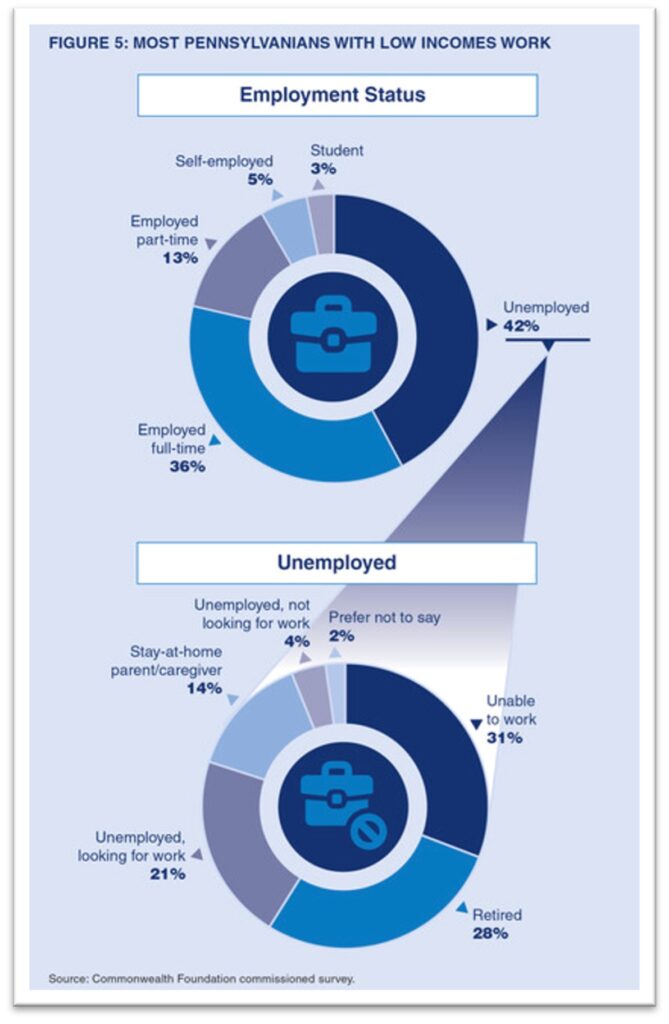Executive Summary

Tearing Down the Barriers to Prosperity: What Pennsylvanians Say About Poverty and Prosperity
Unlike most reports on poverty, this report combines statistics, a survey of Pennsylvanians with income below 200 percent of the poverty line, and in-depth interviews to identify common barriers to prosperity. The findings provide a lens for discussing the lack of prosperity in Pennsylvania and point lawmakers to the barriers that public policies can address, namely the concentration of poverty, government taking too much from Pennsylvanians paychecks, and rules or laws that make it difficult to work and care for loved ones.
Key Findings
- More than half of low-income Pennsylvanians work. Sixty-three percent of respondents were employed, self-employed, or unemployed and looking for work. Of the employed, 62 percent were employed full time.
- The most common reason for not holding or seeking a job is caring for a loved one or child (43 percent).
- Respondents listed debt (46 percent) and taxes (29 percent) as the two most common barriers to financial security. The average respondent pays $4,575 per year in taxes, about $380 per month.
- Poverty in Pennsylvania occurs in urban and rural settings. In fact, four of the five counties with the highest poverty rates are rural.
- Philadelphia has the highest concentration of poverty at nearly 23 percent, while in Forest County it is 19.6 percent. The statewide poverty rate is 12.1 percent.
- Twenty-one percent of surveyed individuals indicated that they knew they were eligible for government programs but chose not to enroll because it was too difficult or not worth it.
Executive Summary
This report seeks to better understand the lived experience of Pennsylvanians with low incomes to eliminate inaccurate perceptions and point policymakers towards the issues that Pennsylvanians experiencing poverty raise. In other words, this study is a lens for lawmakers to use as they explore specific policy solutions.
Here’s where the conventional wisdom is wrong:
Myth: Poverty results from root issues that government must fix.
Fact: Instead of seeing poverty as a phenomenon to eliminate, we need to recognize poverty is common and that the prosperity of our state and nation is relatively unprecedented. Therefore, the question is how to create the conditions for prosperity.
Myth: Most Pennsylvanians experiencing poverty don’t work.
Fact: In our survey, we find roughly two-thirds of those living below 200 percent of the federal poverty level work, and most of those workers work full time.
Myth: Poverty is just an urban problem.
Fact: Research shows four of the five counties with the highest poverty rates are rural. Data from the United States Census Bureau shows poverty is an urban and rural issue with more than 30 counties experiencing poverty rates higher than the state average of 12.1 percent. They include over 22 percent of Philadelphia’s population, 19.6 percent in Forest County, Columbia, Potter, and Fayette.[1] Of the five counties with the highest concentrations of poverty, three saw negative domestic migration.[2]
Myth: The poor don’t care about taxes.
Fact: In our survey, Pennsylvanians with low incomes report taxes are their biggest obstacle to financial security followed by credit card debt, just 24 percent report student debt as a barrier.
Myth: Low-income Pennsylvanians are eager to enroll in entitlement programs.
Fact: About 20 percent of the Pennsylvanians surveyed know they are eligible yet choose not to take advantage of services.
Unsurprisingly, our research indicates women, people of color, young adults, and children are more likely to experience poverty than other groups. However, within these demographic categories the duration and concentration of poverty matters. Concentrations of poverty can lower expectations and access to services and social networks.[3] And the longer a child is impoverished, the more likely they are to experience poverty later in life.[4]
Given what we learned about the experience of Pennsylvanians, this report identifies three policy areas ripe for reform to address tangible government-imposed barriers to prosperity.
- Policies that prevent or reduce the concentration of poverty.
- Policies that allow Pennsylvanians to keep more of their earnings.
- Policies that make it easier for workers with dependents.
Pennsylvanians have enjoyed a remarkable level of prosperity during our short existence. But we can do better. We are facing new challenges with a shrinking and aging population and a diminished workforce. As the costs to care for our elderly population rise, it is more important than ever to tear down barriers to prosperity for all Pennsylvanians.

[1]United States Census Bureau, “SAIPE State and County Estimates for 2021,” December 2022, https://www.census.gov/data/datasets/2021/demo/saipe/2021-state-and-county.html.
[2]United States Census Bureau, “County Population Totals 2020–2021,” https://www.census.gov/data/tables/time-series/demo/popest/2020s-counties-total.html.
[3]C. Andri Mizell, “Racial and Gender Variations in the Process Shaping Earnings’ Potential: The Consequences of Potential: The Consequences of Poverty in Early Adulthood,” The Journal of Sociology & Social Welfare 27, No. 2, (2000), 113–38, https://scholarworks.wmich.edu/cgi/viewcontent.cgi?article=2648&context=jssw&httpsredir=1&referer=.
[4]Mary E. Corcoran and Ajay Chaudry, “The Dynamics of Childhood Poverty,” The Future of Children 7, No. 2 (1997), 40–54, https://inequality.stanford.edu/sites/default/files/media/_media/pdf/Reference%20Media/Corcoran%20and%20Chaudry_1997_Children.pdf.